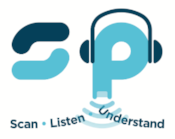Reading and Assistive Technology
If you are, or know someone who is a struggling reader then you probably also know that assistive technology can be a life saver. Technology can help both kids and adults work around their reading challenges.
Learning to read is a complex task. Humans naturally learn to speak but learning to read must be explicitly taught. Even when high quality reading instruction and intervention is provided, learning to read can still be very difficult.
Read aloud tools such as text-to-speech can be the key to unlocking a [reader’s] potential. (Wood and Keelor, 2020)
Using assistive technology (AT) allows readers who struggle to have the support they need to access text. “For people who struggle to read text, technology can be a lifeline. AT can help kids and adults work around their learning challenges. Assistive technology comes in many forms and can be used on computers, smartphones, and with hand-held devices. Text-to-speech and audiobooks are two examples of reading technology.” (1)
Using assistive technology helps to level the playing field for kids and adults who struggle with print. Schools can use AT alongside explicit reading instruction to support students’ vocabulary and comprehension development. Adults can use AT in the workplace to maintain productivity and normalize neurodiversity in businesses.
Awareness about assistive technology continues to improve as technology itself not only improves, but becomes even more essential at school, work, and home.
Here are a few common myths about using assistive technology. (3)
Myth #1 – AT gives students an unfair advantage.
Technology provides equal access to the same learning experiences.
Myth #2 – Digital natives can teach themselves the best ways to use AT in school.
Students need guidance and support while figuring out how best to apply technology to educational experiences.
Myth #3 – AT can replace good teaching.
AT is an effective accommodation. When paired with good teaching, AT becomes a portal to academic success.
Myth #4 – Adults who struggle are too old to start using AT.
Now that assistive technology tools can be found on practically every computing device, many adults with struggles already have these tools at their fingertips.
While learning to read can be challenging for some, it does not mean they are not smart. The most common reading difficulty, dyslexia, is not associated with intelligence. Moreover, signs of reading difficulties like dyslexia are visible as early as 4 – 5 years old.
Assistive technology can be used at any time to support a child; no formal prescription is needed. Don’t wait until a child is “older” to provide reading intervention and access to supportive tech tools. Begin using assistive technology, like text-to-speech or speech-to-text, as soon as a learner seems ready for the tool that will best support them.
Here are a few common warning signs of dyslexia, the most common reading difficulty. (2)
Difficulty recognizing letters, especially the letters in their name.
Difficulty recognizing or saying words that rhyme.
Mispronouncing words like “beddy tear” instead of “teddy bear.”
Difficulty learning the alphabet or days of the week.
Trouble remembering how words are spelled or how to use spelling rules taught in school.
Confusing or skipping small words like "for” and “of” when reading aloud.
If you see these signs consistently over time (i.e. the whole school year) reach out to school professionals like teachers, reading specialists, speech-language pathologists, or school psychologists. Don’t wait to ask for help. Dyslexia is not outgrown.
To encourage literacy development at home, consider the following: (1)
Make a habit of reading at home and at bedtime.
Play rhyming games and read familiar signs in the environment.
Talk, sing, and tell or retell stories to encourage oral language skills.
To counteract the negative impact of reading struggles, provide access to print with assistive technology and text-to-speech.
At home, in school, and in the workplace, assistive technology not only provides access to text but also independence and confidence with reading related tasks. Using the right tool for the job is something we all strive to do. Using technology to help with reading difficulties can help to normalize it in any setting. The next time a struggling reader you know needs support, remember that assistive technology could be just the thing they need.
Learn more from these references:
1 Assistive Technology for Reading | Understood - For learning and thinking differences
2 Dyslexia Symptoms in Children and Adults | Understood - For learning and thinking differences
3 7 Myths About Assistive Technology Explained. Jamie Martin.pdf

